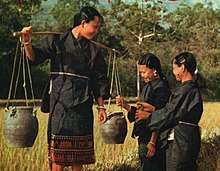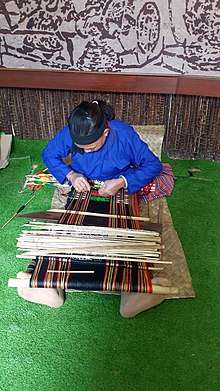Hlai people
The Hlai, also known as Li or Lizu, are a Kra–Dai speaking ethnic group, one of the 56 ethnic groups officially recognized by the People's Republic of China. The vast majority live off the southern coast of China on Hainan Island,[2] where they are the largest minority ethnic group. Divided into the five branches of the Qi (Gei), Ha, Run (Zwn), Sai (Tai, Jiamao), and Meifu (Moifau),[3] the Hlai have their own distinctive culture and customs.
 | |
| Total population | |
|---|---|
| 1,247,814 | |
| Regions with significant populations | |
| Hainan, Guangdong and islands in the South China Sea | |
| Languages | |
| Hlai languages, Jiamao, Hainanese, and Mandarin | |
| Religion | |
| Animism, Theravada Buddhism | |
| Related ethnic groups | |
| other Tai-Kadai peoples and populations from mainland southern China[1] |
| Hlai people | |||||||||
|---|---|---|---|---|---|---|---|---|---|
| Chinese | 黎 | ||||||||
| Literal meaning | [phonetic] | ||||||||
| |||||||||
| Alternative Chinese name | |||||||||
| Chinese | 黎族 | ||||||||
| Literal meaning | Li Ethnicity | ||||||||
| |||||||||

Names
"Li" is the Chinese transcription of their native name, which is Hlai. They are sometimes also known as the "Sai" or "Say". During China's Sui Dynasty, their ancestors were known by various names, including Lǐliáo (俚僚), a general term encompassing several non-Han ethnic groups in Southern China. The name Li first is recorded during the Later Tang period (923–937 CE).[4]
History
The Hlai are believed to be descendants of the Rau people, Kra-Dai speaking tribes of ancient China, who settled on the island thousands of years ago.[5] DNA analysis carried out amongst the modern Hlai population indicate a close relationship with populations in the southern Chinese province of Guangxi,[1] most of them have Y-DNA O1a and O1b.
During the Japanese occupation of Hainan (1939–1945), the Hlai suffered extremely heavily due to their communist resistance activities especially in the western Hainan. Hlai villages were frequently targeted for extermination and rape by Nationalist and Japanese soldiers. In four towns alone, the Japanese slaughtered more than 10,000 Hlai people.[6] In another incident, Nationalist forces massacred over 7,000 Hlai in a village. Nationalist officers had 9,000 Hlai and 3,000 Miao executed after tricking them to the war fronts during a fake conscription campaign. As the Nationalists retreated with over 1.5 million civilians that they evacuated to the hills with, they massacred and stole food from the ethnic Hlai as well as other tribal peoples. The Nationalists executed 2,180 Miao women and children of Baisha and Baoting uprising origin.[7] Tens of thousands of Hlai were also killed in Japanese labour camps, as unlike other Chinese civilians they and the Tanka were not evacuated by Chinese Nationalists to safety zones. Undercover Nationalist agents pretending to work for the Japanese observed how Japanese commanders gunned down thousands of Hlai while trying to escape the camp.
They are held in high esteem by the Beijing government because they fought on the side of the CPC against Chinese Nationalist rule during the Chinese Civil War. Hainan Li-Miao Autonomous Prefecture was created in 1952 (abolished in 1988).
Language
The Hlai speak the Hlai languages, a member of the Kra–Dai language family,[8] but most can understand or speak Hainanese and Standard Chinese. The language spoken natively by the Sai (also known as Tai or Jiamao) subgroup has been noted for its dissimilarity to the dialects or languages spoken by the other subgroups of the Hlai.
Culture
Among the Hlai, the women have a custom of tattooing their arms and backs after a certain age is reached. The Hlai play a traditional wind instrument called kǒuxiāo (口箫),[9] and another called lìlāluó (利拉罗). The Hlai people were considered to be barbaric and primitive and were among the lower classes in Hainan. The Hlai in Wenchang assimilated into the local population and pretended to be Hainanese while most of the Hlai population was exterminated in most other parts of Hainan only a small portion of the Hlai survived and fled to the mountains where they still maintain a Hlai identity.
Notable people
- Su Yunying, singer
References
- Peng, Min-Sheng; He, Jun-Dong; Liu, Hai-Xin; Zhang, Ya-Ping (15 February 2011). "Tracing the legacy of the early Hainan Islanders - a perspective from mitochondrial DNA". BMC Evolutionary Biology. 11: 46. doi:10.1186/1471-2148-11-46. PMC 3048540. PMID 21324107.
- Original from Indiana University Viscount James Bryce Bryce (1904). Hans Ferdinand Helmolt (ed.). The World's History: Oceania, Eastern Asia and the Indian Ocean. Volume 2 of The World's History: A Survey of Man's Record. LONDON: William Heinemann. p. 60. Retrieved Dec 20, 2011.
extended as far as the Han River, and the Man lived on the central and upper Yangtsze, chiefly on the right bank. But the number of the tribes that had not then been subdued must have been much greater; even at the present day, more than two thousand six hundred years later, tribes of original inhabitants in complete or partial independence are constantly found in the southern and western provinces of the empire. That such tribes as the Hlai (Limin or Limu, probably descendants of the Miaotsze to whom Kublai Khan [Shi Tsu] is said to have assigned a part of Formosa in 1292) should have held their ground in the interior of Formosa and Hainan is the less remarkable, in view of the fact that even at the present day whole tribes of original inhabitants have been able to maintain their independence in the provinces on the mainland, where the Chinese supremacy has endured for hundreds or thousands of years. The Miaotsze are divided into sung (savage) and shuh (domesticated) according to the amount of Chinese civilization which they have acquired, and live to the number of fully eighty different tribes in Kwangtung, Kwangsi, Hunan, Yunnan, and Kweichau. They are supposed to be relations of the Siamese and Burmese, and possibly the Hakkas belong to the same race; these foreigners are said to have immigrated into the two Kwangs apparently at the time of the Mongol dynasty of Kiangsu or Shantung, in 1205-1368. It was not until 1730 that the Miaotsze in Yunnan and Kweichau were subjected to the Chinese supremacy, whereas in Kwangsi independent tribes still maintain their existence. The Yao or Yau yin, also said to be members of the Miaotsze, lived in Kwangsi until the twelfth century and then migrated to the peninsula of Liauchau, where they still continue a half-independent existence; in 1832 they began a revolt which was only suppressed with difficulty. The other great group of original inhabitants which has maintained itself within the country is that of the Lolo in Szechwan and Yunnan, who are thought to be related to the Kakyes, Shans, and Burmese; they are also divided into tribes which have made a nominal submission to the Chinese and tribes which decline to allow the Chinese a passage through their mountains, whence they make raids upon the surrounding districts.
- "Chinese Nationalities (Li Minority)". Retrieved February 18, 2011.
- "黎族 (The Li People)" (in Chinese). 国家民委网站 (State Ethnic Affairs Commission). 14 April 2006. Retrieved 22 March 2020.
在我国古籍上很早就有关于黎族先民的记载。西汉以前曾经以 “骆越”,东汉以“里”、“蛮”,隋唐以“俚”、“僚”等名称,来泛称我国南方的一些少数民族,其中也包括海南岛黎族的远古祖先。“黎”这一族称最早正式出现在唐代后期的文献上...... 南朝梁大同中(540—541年),由于儋耳地方俚僚(包括黎族先民)1000多峒 “归附”冼夫人,由“请命于朝",而重置崖州 。
- "Li | Asian people". Encyclopedia Britannica. Retrieved 2018-10-24.
- "Zhonghua min guo shi lu: Min guo yuan--san shi ba nian (1912.1.1.-1949.9.30)". 1998. Missing or empty
|url=(help) - (China), 中南民族学院 (1989). "Journal of South Central College for Nationalities: Philosophy and social sciences". Missing or empty
|url=(help) - Norquest, Peter K. 2007. A Phonological Reconstruction of Proto-Hlai. Ph.D. dissertation, Department of Anthropology, University of Arizona.
- "Archived copy". Archived from the original on 2007-12-08. Retrieved 2007-12-03.CS1 maint: archived copy as title (link)